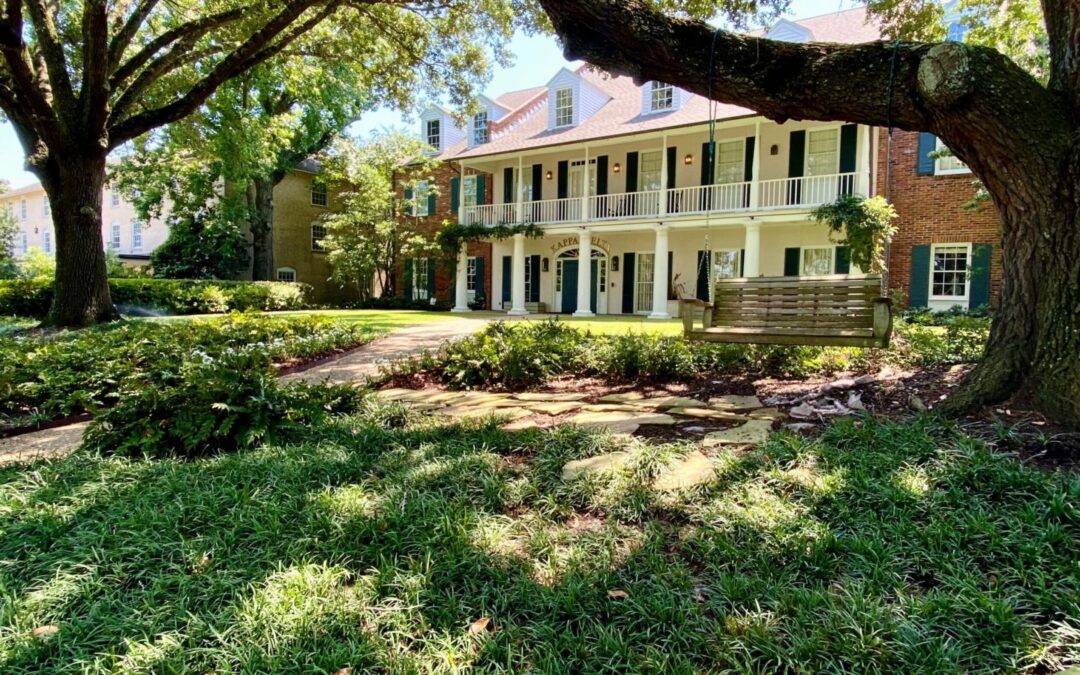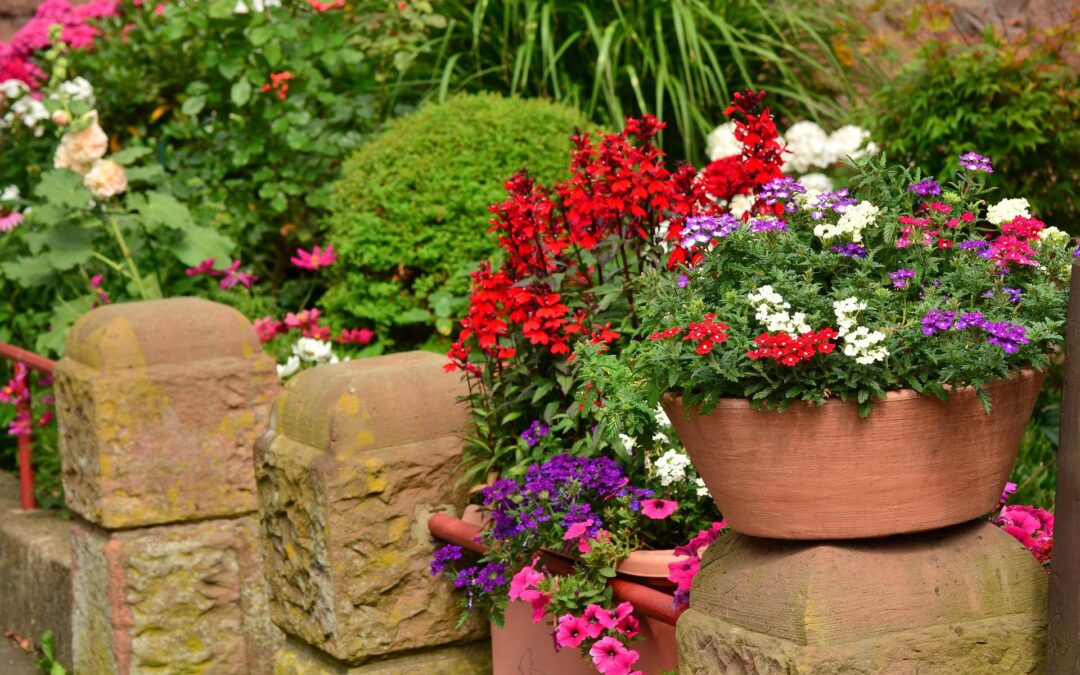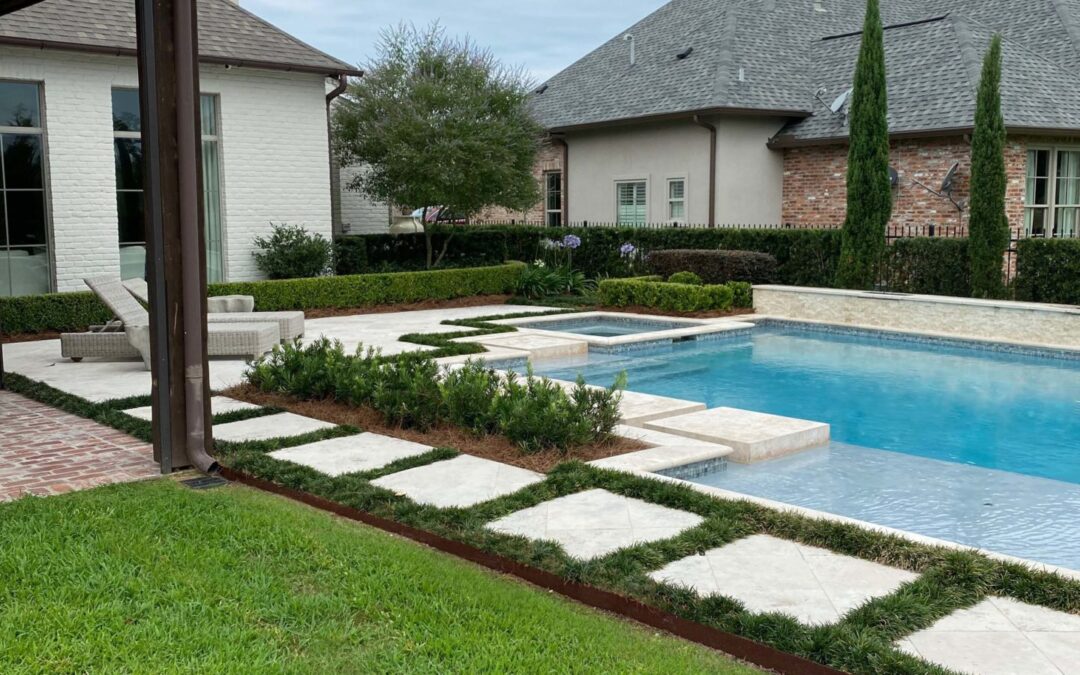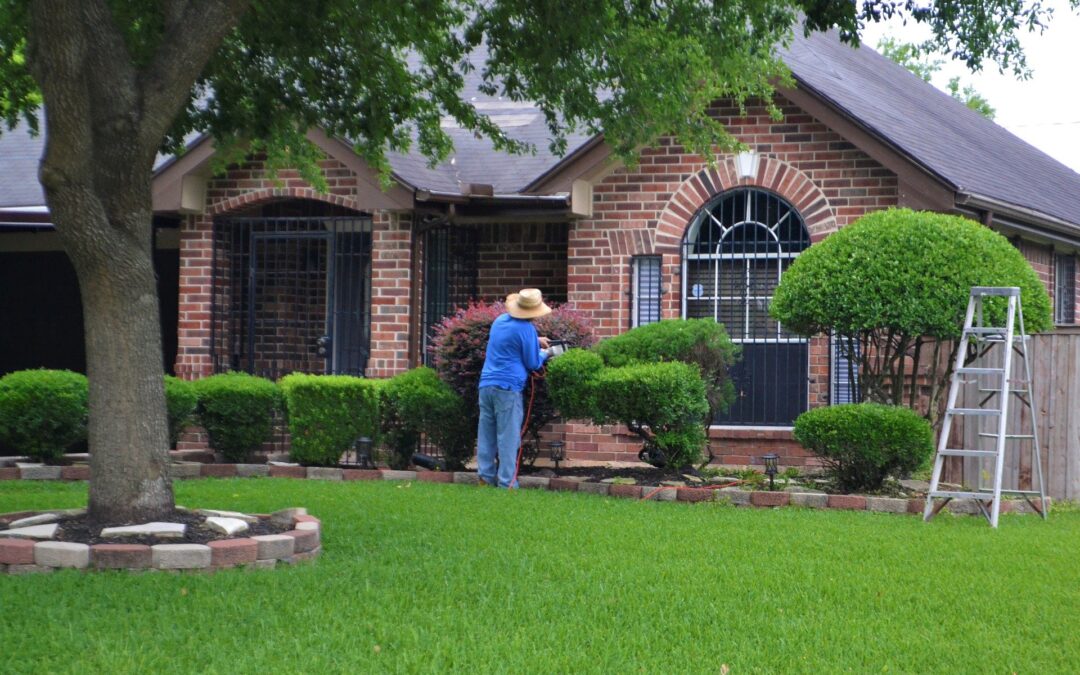
by leesonlandsca1 | Aug 11, 2022
Although there are still several more weeks of warm weather in Baton Rouge, now is a great time to begin planning your fall and winter landscaping. Many plants that will thrive in Baton Rouge in the winter need to go into the ground early in the fall to truly look their best. Taking the time to plan out a winter landscape now will keep your home or business looking vibrant even as grass and summer flowers start to turn brown and die off as cooler weather approaches.
Winter Flowers to Plant in the Fall in Baton Rouge
Although summer is often considered the best time for flowers, many blooms do best in Baton Rouge in the winter, particularly in the warmer local climate. Some of the flowers you could consider planting this fall includes:
- Geraniums
- Pansies
- Carnations
- Violets
When planted from seed, these flowers will begin blooming later in the fall and can continue to flower throughout much of the winter, especially if you provide regular fertilization and trim off any blooms that are starting to wilt. If you are planting seedlings or established flowers, they can go in the ground a little later in the season.
Fall and winter are also the best times for planting several varieties of trees and shrubs in Baton Rouge since the cooler temperatures make it easier for these plants to become established before they endure the heat. But you do still need to be aware of the potential for cold snaps that could put too much stress on new plants. Those that thrive in cooler temperatures and will generally do well planted in the winter include shrubs and trees like:
- Azaleas
- Magnolias
- Willow Oaks
- Vytex Trees
- Hydrangeas
- Camelias
One of the best ways to be sure that you have beautiful fall color at your property is with seasonal color changeouts from Leeson Landscape. For many of the properties we work with, we can plant fall-ready flowers that will offer beautiful blooms and colors to keep your property looking beautiful all year long. Contact our team for more information on our year round landscaping services in Baton Rouge.

by leesonlandsca1 | Aug 5, 2022
New plants are most delicate in the weeks immediately following planting. During this time, they are establishing their roots, a process that requires them to have ample water and the right growing conditions.
This is especially important for trees, which are often a significant investment in your landscaping, and you want to be sure you are providing the right care so that the tree will grow a strong root system and be healthy for many years to come. The health of your tree begins with the correct watering schedule.
Determining the Best Watering Schedule for New Trees
How often and how much you should water a sapling depends on the type of tree, its size, where you plant it, and other weather conditions. In general, you should water any tree within a few hours after planting it, and then water the tree daily throughout the first week. At this point, the tree will be slightly more established and should be able to go about a week between waterings depending on the weather.
The amount of water you need to use will depend almost entirely on the type of tree. For most trees, several gallons of water is often required. The best way to do this is to water slowly to give the water time to absorb into the soil below.
To give you an idea of watering routines, these are the water requirements for a variety of trees that grow well in Baton Rouge:
- Meyer Lemon Trees – These are smaller trees that are both ornamental and provide the benefit of fresh lemons. You want to water lemon trees once a week so that the soil around the tree is kept moist, but should not be flooded. These trees also need weekly waterings throughout their lifetime.
- Spruce Pine – A spruce pine fully grown can be up to 60 feet tall, making for an impressive tree at Baton Rouge properties. A new spruce pine should be watered throughout the first year to keep the top inch of soil moist. After a year, a spruce pine is often established enough to survive on its own with just rain.
- Crepe Myrtle – A crepe myrtle is about 20 feet high with beautiful pink blossoms in the spring. They need weekly watering in the beginning. For each watering, you should plan to water slowly for about an hour to get the tree the amount of water it needs.
These guidelines are for trees planted directly into the ground. Trees in pots have slightly different requirements and will not need as much water since the water will be contained in the pot. This may mean that even for new trees, you will not water every day. Instead, water anytime at the top 2 inches of soil in the pot feels dry, and continue to water until you notice water draining from the bottom of the pot.
While your tree is becoming established, pay daily attention to it until you get a feel for how weather, the amount of shade and sunlight, and other factors are affecting how quickly it dries out. This ensures that you have a beautiful tree for many years.
Leeson Landscape is a Baton Rouge landscaper and landscape maintenance company that you can also rely on for tree planting services. Whether we are helping you establish your landscape or keeping new plantings thriving with our ongoing landscape maintenance services, we will keep your yard looking its most beautiful. Call us to learn more.

by leesonlandsca1 | May 23, 2022
Flowers, shrubs, ornamental trees, and herbs growing in containers around your yard are a great way to add visual interest to your landscaping. They add height and also incorporate the decorative containers of your choice.
Regardless of what you are growing, planting in containers is somewhat different than planting in the ground, but with the right preparation steps, you can soon have a beautiful display of vibrant container flowers or manicured shrubs and ornamental plants around your home or business.
How to Grow Plants in Containers
Many of your favorite flowers, shrubs, and vegetables can be grown in a container as well as in the ground. Here in Baton Rouge, containers offer additional benefits for some plants since they give you the ability to more closely control the temperature and environment by keeping plants off the ground or moving smaller containers around, or even indoors during inclement weather.
For any plants that you are planning on growing in a container, use the following steps to ensure healthy growth:
- Select the Right Container – Almost any container can be suitable for plants, although some will be easier. In addition to choosing one that matches the rest of your landscaping and your personal aesthetic, keep in mind that larger containers work better since they hold more soil, water, and nutrients and give your plants more room to spread. Glazed ceramic is a durable outdoor option. Metal is as well, although it does best in shape since otherwise it may get too warm and scorch your plants’ roots. Your container will also need at least one drainage hole on the bottom.
- Fill Your Container – Add a layer of stone or small pebbles to the bottom of your container. This will promote good drainage. Cover this rock layer with a mesh gardening fabric to prevent soil from falling through and then fill the rest of the container with your soil, using the right blend for the specific plants that you are growing.
- Hydrate the So- Because you will be using potting soil rather than ground soil, the dirt will most likely be dry and potentially hydrophobic, meaning it will not absorb water. To rehydrate the soil before you put your plants in, add water to the container and then give it time to soak into the soil. When the soil is noticeably moist when you handle it, you are ready for planting.
- Consider Your Placement – Containers are more susceptible to temperature changes and ambient conditions because they are off the ground. A rise in temperature or direct sunlight will quickly heat up your container, making it more likely to dry out and overheat. The benefit of a container is that you can place it in the optimal position for the plants who will be growing, whether they need full sun, partial sun, or mostly shade.
- Grow Your Plants – Add your plants to your container and let them start to grow, using the right fertilization and watering for the type of plants you have. Especially in the beginning, monitor carefully until you get a feeling for it how quickly your soil dries out. You can test by sticking your finger 2 inches into the soil to determine if it is still moist or needs more water.
If you have container plants or want to add some to your landscape, Leeson Landscape is a Baton Rouge landscaping and maintenance company that can keep your existing container plants thriving and help make beautiful container gardens part of your next landscaping project. Call us to get started.

by leesonlandsca1 | May 19, 2022
Pavers are the ultimate solution for pathways and patios at many properties. With so many different paver options to choose from, cement pavers, flagstones, and brick pavers, and all the different shapes and textures these offer, will fit the style of every landscaping.
You can further customize your paver path by choosing what goes in between them. Cement is an option for a permanent look. Decomposed granite or another small stone has also long been a popular choice for keeping pavers in place and preventing weeds and other unwanted debris from collecting between them. But if your pavers have a few inches of space in between them, this is also a great opportunity to add more greenery to your landscape.
Plants that Will Grow Well in Paver Walkways
The right plants growing among your paving stones or your paver patio will make the pavers blend more seamlessly into the landscape. The flagstones will start to look like a part of the natural setting rather than something that cuts through it. Like cement or gravel, healthy plants will also prevent weeds from sprouting instead.
But it is important to choose the right types of plants. You still need your walkway to be accessible and should avoid any plants that grow tall and would require people to step over them. Plants also should not grow to cover a paver since this can become a tripping risk. Plants that develop strong root systems could also affect the walkability of your pathway by pushing pavers out of place.
The other consideration is maintenance. Since paver patios and pathways can be expansive, you will likely want plants that require limited upkeep. This leaves many ground cover plans as the perfect options for planting between pavers including:
- Turf Grass – If your pathway runs through your lawn or your patio sits adjacent to grass, an easy and attractive solution is to let the grass grow in the space around the pavers. This will let your pavers seamlessly mesh with your lawn and allows for simple maintenance since you can rely on your existing irrigation system and mowing to keep grass maintained.
- Moss – Moss will give your landscaping a more lush feel and it is generally slow growing so maintenance needs are limited. Year round moisture is a must and moss will struggle in areas of full sun.
- Creeping Thyme – This herb will provide wiry and thick ground cover between pavers. Be sure to choose creeping thyme since it grows outward not up, and watch to be sure that it is not starting to grow over the pavers themselves
- Clover – One of the easier growing plants, clover will give you a soft and grassy texture between pavers with a little more definition than standard turf.
- Blue Star Creeper – For flowers between pavers, blue star creeper is the ideal option, offering delicate, pale blue blossoms with bright green leaves. It is highly resilient and does well in a shady environment.
Paver plants will need at least a few inches between stones in order to establish their roots and have enough room to grow. Some plants may need a little more space than others.
When choosing which to plant, you also need to be sure you have the right conditions in terms of shade, water, and soil type to help your plants become established. As landscaping and garden care experts in Baton Rouge, Leeson Landscape can create the perfect backyard for local homeowners, combining natural elements with your hardscaping. Get more information on our landscaping services when you contact our team.

by leesonlandsca1 | Mar 31, 2022
Large trees that provide ample shade offer several benefits around your home or business property. The shade provides relief from heat when outdoors, particularly in the warmer summer days in Baton Rouge. The tree can also shelter your property from sunlight, meaning more efficient cooling and moderate protection from wind and rain as well.
Trees native to Baton Rouge also offer many beautiful options with lush green leaves, bright fall colors, and dynamic shapes that are valuable additions to your landscaping and curb appeal. These are some of the best shade trees to consider for your property in Baton Rouge.
Fast Growing Shade Trees for Your Yard
One drawback to many shade trees is that they can take some time to grow to maturity and start providing adequate shade. Shade trees tend to be larger which is why they work well for shade, but native Louisiana oaks, for instance, can take several decades to grow from a sapling to a shade tree. This is not ideal when you want to introduce natural shade to your landscaping.
Instead, these fast growing trees give you a range of aesthetic options, sizes, and shapes for a tree that will provide extensive shade and enhance the appearance of your property within just a few years:
- Willow Oaks – One of the oaks that does grow quickly, a willow oak has bright green leaves similar in shape to the willow tree. The leaves turn a rusty red color in the fall. Once established, a willow oak can grow up to approximately 2 feet per year to reach a full height of 70 to 80 feet.
- Sycamore Tree – A beautiful tree native to the south, a sycamore tree grows approximately 2 feet a year until it reaches a majestic height of up to 100 feet with leaves that spread 40 to 70 feet, offering plentiful shade.
- Slash Pine – For evergreen shade, the slash pine produces long needles and bunches of pine cones. It has a medium growth rate averaging 1 to 2 feet and can reach a height of 80 feet.
- Weeping Willow – The weeping willow is an easily identifiable shade tree with its graceful trailing branches. As a young tree, it grows quickly, increasing its height by up to 10 feet per year until it reaches 50 feet making it a great tree for fast shade.
- Drummond Red Maple – The red maple has bright green leaves in the summer before turning to a brilliant red color in the fall. Also known as the swamp maple, this native maple is hardy and does well in Baton Rouge where it grows up to 2 feet per year and can reach a height of 60 feet.
- Blackgum Tree – Prized for its fall color with bright red leaves, the blackgum tree is a hardy shade tree that can survive many environments. It has a fast growing rate and can get up to 80 feet.
- Fan Tex Ash – For a smaller shade tree in more confined spaces, the fan tex ash reaches a height of about 35 to 40 feet. Its golden yellow leaves provide beautiful colors in autumn.
With a wide variety of shade trees that grow well in Baton Rouge, you have many options for customizing the shade in your yard. You can choose from a large tree like a sycamore oak or pine to provide the widest possible area of shade or a maple or blackgum tree for its autumn colors. Alternatively, combine trees for a unique landscaping look and optimal shade.
For beautiful landscaping, Leeson Landscaping can incorporate a range of shade trees on your property, from planning to planting to pruning your shade trees to help them reach their full potential for beautiful shade. Contact us to learn more about our Baton Rouge landscaping services.





